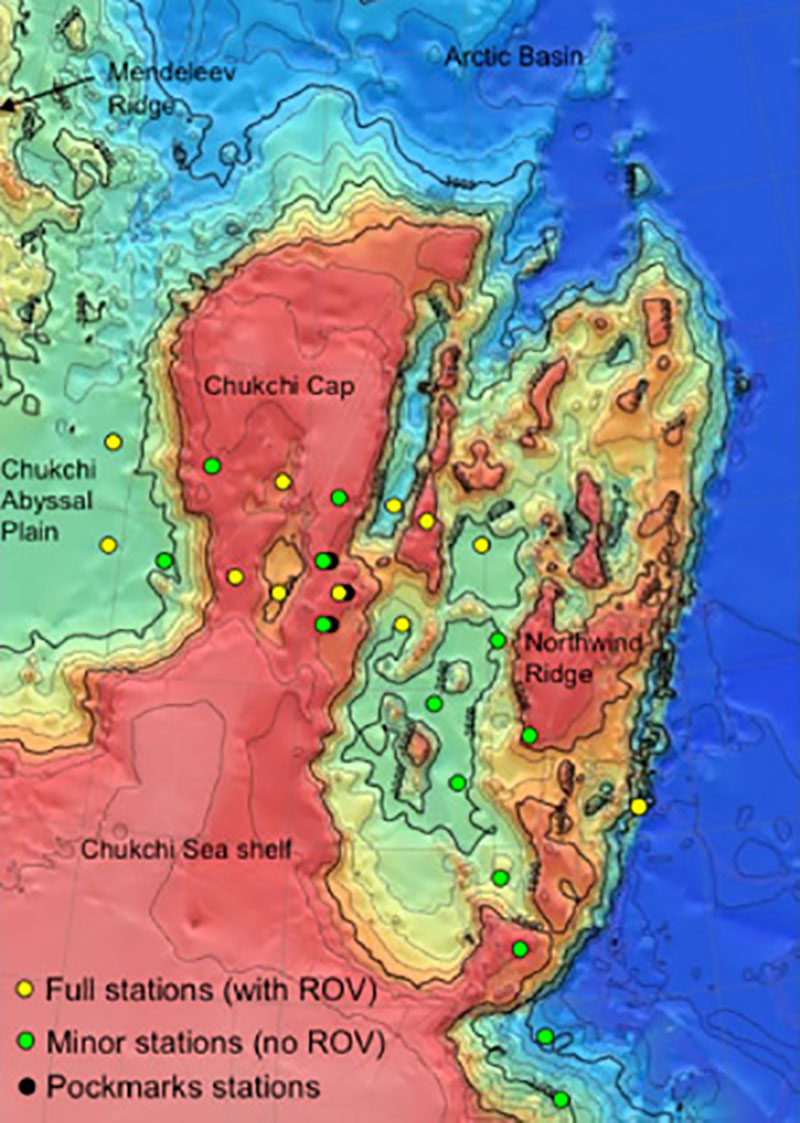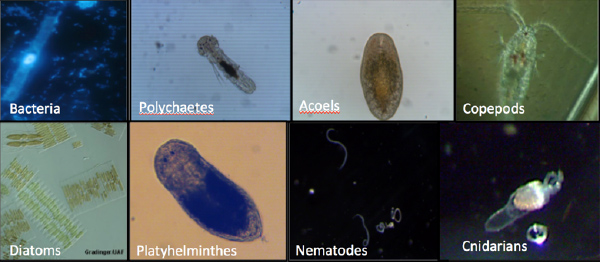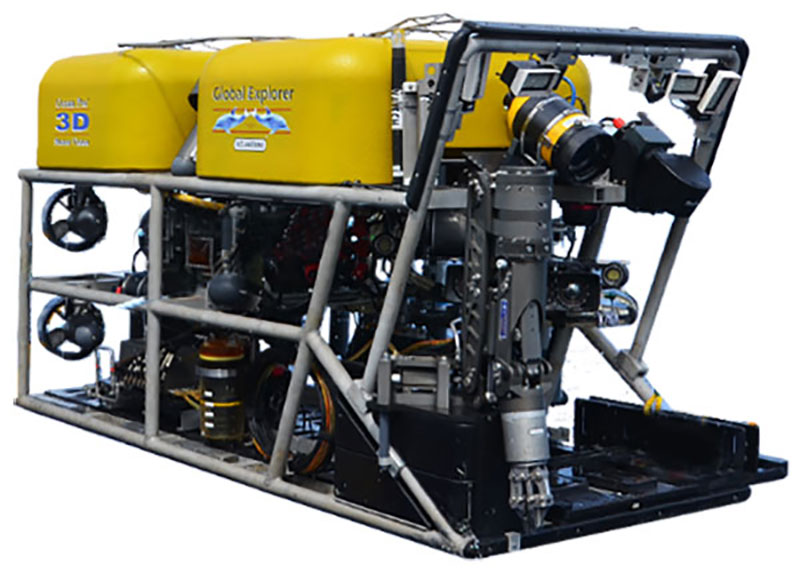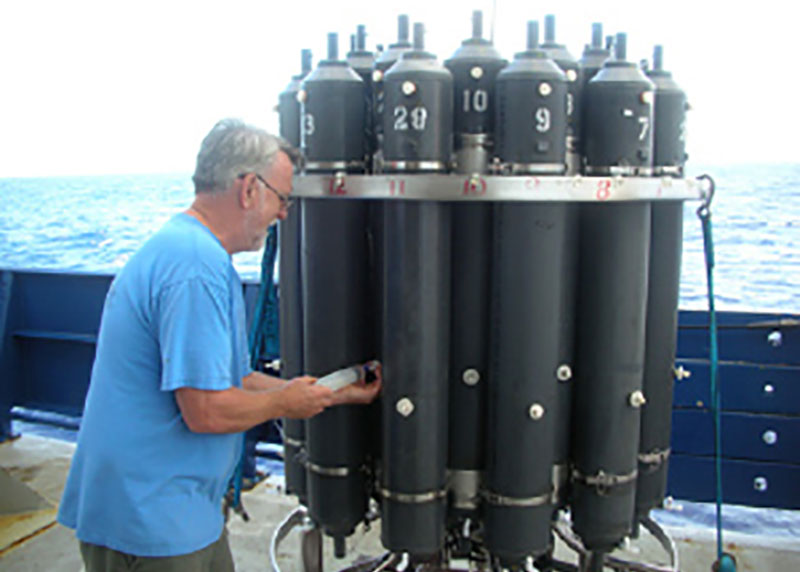

Bathymetry of Chukchi Borderlands with tentative stations positions. Image courtesy of M. Edwards, University of Hawaii. Download image (191 KB).
The Chukchi Borderlands (CBL) region is located to the north of Alaska, with water depths ranging from the shallow shelf edge to 3,000 meters. Here there is a dynamic mixing of waters from the Arctic, Pacific, and Atlantic, moving over a complex array of canyons, ridges, trenches and creating complicated currents and sea ice drifts.
The sea ice, pelagic (water column), and benthic (ocean bottom) communities of this region are tightly linked physically, chemically, and biologically, yet these interactions are poorly understood.
This mission is a multifaceted, multidisciplinary exploration to better understand the interdependence of these three marine communities (and more), in the wake of rapid environmental change.
Climate change has been most noticeable in the Arctic region, with this area experiencing some of the most dramatic summer sea ice melt in the last few decades. Predictions of an ice-free Arctic by the summer of 2030 make the documentation of current species composition, community structures, and habitat interactions of the Arctic organisms an urgent challenge, particularly in the least explored regions, such as the CBL.
From July 2 to August 10, 2016, explorers will use a combination of photographic mapping, physical sampling, and state-of-the-art metagenomics to assess the diversity of this region to better understand the sea ice, pelagic, and benthic realms and how they influence one another.
Sea Ice Realm
The sea ice component of this expedition will explore genetic diversity by integrating data collected from the unique physical and chemical environmental settings of sea ice brine channels (small channels of liquid sea ice brine meandering throughout the frozen sea ice).
The science team expects to discover new taxonomic diversity in prokaryotic, eukaryotic, and viral communities of Arctic sea ice by sequencing of DNA barcoding regions; identify patterns and infer community dynamics among bacteria, archaea, viruses, eukaryotic protists, and meiofauna; and predict functional relationships among microbes.

Microbes and meiofauna associated with sea ice are often similar to those found in sediment. Image courtesy of K. Dilliplaine. Download image (86 KB).
Pelagic realm
The pelagic component of this expedition will provide species inventories of pelagic organisms (zooplankton and nekton), including poorly known deepwater and gelatinous zooplankton; relate the distribution of organisms to the water masses encountered in this region; and produce still and video imagery of living organisms to publish and share exciting new findings.
Benthic realm
The benthic component of this expedition will focus on exploration of benthic invertebrate and fish communities with links to top trophic level marine mammals. This work will include gathering inventory of benthic invertebrates and fishes inside and outside several unique “pockmark” locations with special focus on communities that might indicate seep activity.
Some of the Chukchi Plateau’s most intriguing bottom features are mysterious pockmark-like fields that were presumably formed ~65,000 years ago (Astakhov et al., 2014). In general, pockmarks are seabed craters of <1 to >100 meters in diameter, usually formed through seepage of gases (methane or carbon dioxide), pore fluids in soft-sediment areas (Hovland & Judd, 1988; Vogt et al., 1994), and/or destabilizing gas hydrates (Wood et al., 2002).
Investigation of one potential old pockmark during the Hidden Ocean Arctic 2005 expedition revealed no evidence for chemosynthetic communities, but showed it to be a hotspot of biological activity with great potential for further new discoveries (MacDonald et al., 2010).

Crossota sp., a deep red medusa found just off the bottom of the deep sea. Image courtesy of Kevin Raskoff, California State University. Download image (60 KB).
Exploration and sampling tools for this expedition will include:

ROV Global Explorer. Image courtesy of Deep Sea Systems International, Inc. Download image (jpg, 83 KB).

A scientist extracts water from one of the sample bottles in the CTD rosette. Image courtesy of the NOAA Office of Ocean Exploration and Research. Download image (jpg, 68 KB).
This expedition provides unique opportunities to better understand the intricate relationship between the sea ice, water column, and ocean floor communities of this fragile, unknown ecosystem. This work will contribute to improving “baseline observations and understanding of Arctic climate and ecosystems to reduce the uncertainty in assessing and predicting impacts caused by a changing Arctic” (NOAA Arctic Vision and Strategy Plan 2011).